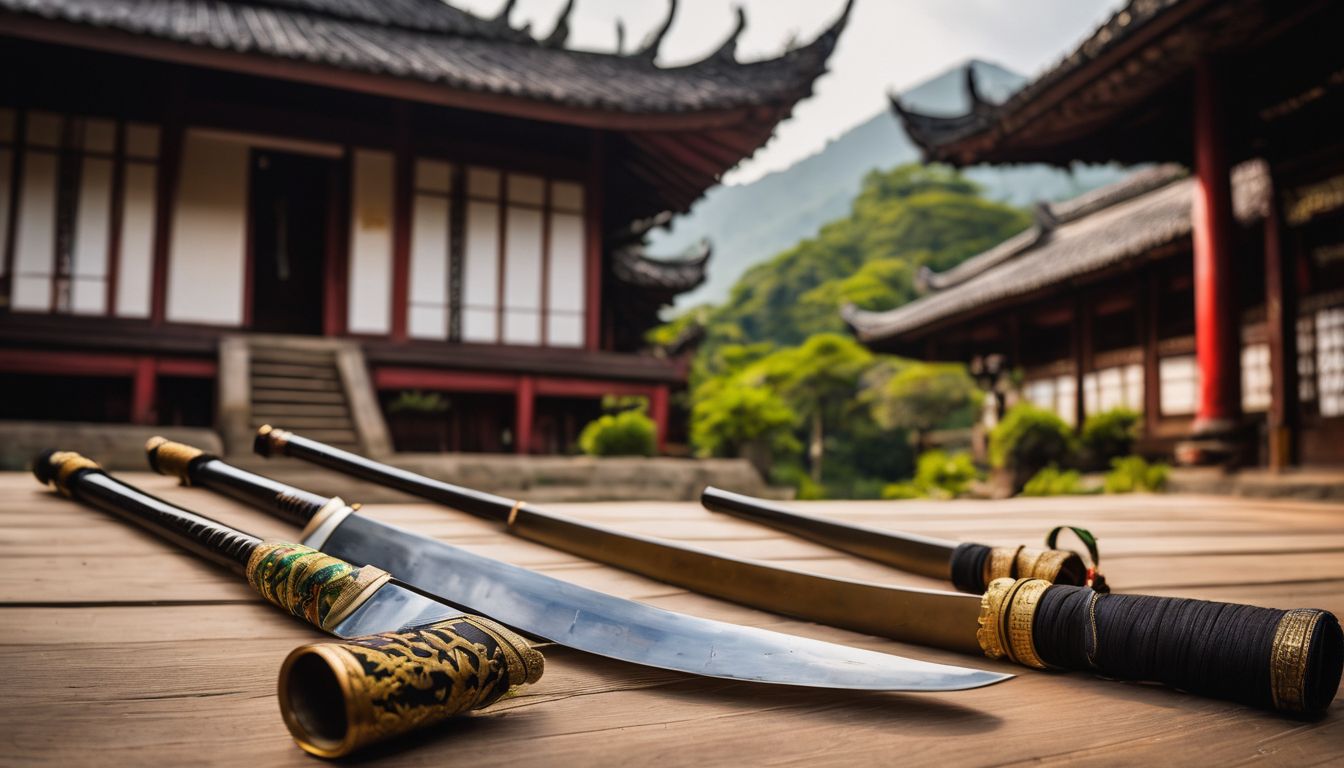
Are you intrigued by the ancient art forms that have shaped cultures and defended nations? Southeast Asia’s martial arts are not just about combat; they encapsulate a heritage rich with history and tradition.
This article will unveil the world of fierce kicks, strategic strikes, and philosophical depth that form the core of these traditional defense arts. Dive in to learn how warriors of old still influence today’s fight craft.
Key Takeaways
- Southeast Asia’s martial arts are more than fighting; they show the history and culture of each country. Styles like Muay Thai, Silat, Arnis, Lethwei, Muay Lao, Kuntao, and Bando have roots in ancient times.
- Martial arts mix fight moves with deep thoughts and beliefs. They help people grow strong in both mind and body. Training includes learning about inner peace and respect for life.
- Keeping martial arts alive today is tough but important. People work to save these old skills through projects like archives. These practices bring folks closer to their past and help different cultures connect.
- Southeast Asian textiles also share much about the region’s history through lovely designs that carry cultural meanings. They tell woven histories from long ago just like martial arts do with physical movements.
The Rich Tapestry of Southeast Asian Martial Arts

Delve into the intricate mosaic of Southeast Asia’s martial arts, a vibrant spectrum where each style reflects deep cultural roots and historical narratives. This colorful heritage reveals not only diverse combat techniques but also illustrates regional identities through every disciplined movement and philosophical underpinning.
The Cultural Significance of Martial Arts in Southeast Asia
Martial arts in Southeast Asia are not just about fighting. They are a key part of culture and history. People in this region have been practicing these arts for a long time. These practices show the values, stories, and traditions of each place they come from.
The moves and styles in martial arts tell about the past. Many areas were influenced by Indian culture. This is seen in the way they fight and move. For example, silat shows how trade and war shaped Malaysia, Singapore, and Southern Thailand’s fighting techniques.
These arts connect people today to their ancestors’ ways of life. They also make friends between different countries through sharing their skills and stories.
A Snapshot of Diverse Martial Arts Styles
Southeast Asia’s martial arts are more than just fighting techniques; they carry deep cultural stories. Now, let’s explore the variety of martial arts styles from this region:
- Muay Thai is often called Thai boxing and is famous for its stand-up striking and clinching moves. It uses punches, kicks, elbows, and knee strikes to make a full-body fight.
- Silat is practiced across the Malay Archipelago and includes many different styles. This art form uses strikes, joint manipulation, bladed weapons, and throws.
- Arnis, also known as Eskrima or Kali, comes from the Philippines. Fighters use sticks, knives, bladed weapons, and various improvised arms to defend themselves.
- Lethwei, from Myanmar, is known as “The Art of Nine Limbs.” It’s like Muay Thai but allows headbutts and has fewer rules for a more intense combat.
- Muay Lao is similar to Muay Thai but comes from Laos. It focuses on rhythm and uses music in training sessions to help fighters learn movements.
- Kuntao blends techniques from different cultures in Southeast Asia. It shows how people shared their fighting skills with neighbors.
Spotlight on Key Martial Arts of Southeast Asia

Delve into the heart of Southeast Asia’s martial arts heritage as we shine a light on pivotal combat practices that have been honed through centuries. Witness how each art form, unique in its essence, contributes to a collective legacy of traditional warrior training and self-defense skills.
Muay Thai: Thailand’s National Sport
Muay Thai is the national sport of Thailand and a big part of their culture. This sport is like kickboxing but with some old-school moves. It’s fast and strong, which makes it a tough martial art.
Fighters train hard to be good at using their hands, feet, knees, and elbows in fights.
Long ago, soldiers in Siam (that’s what they called Thailand back then) practiced Muay Thai for battle. Now people practice it not just to fight but also because it’s an important tradition.
You might see Muay Thai in the Southeast Asian Games where athletes show off their skills.
Even though there are arguments about where Muay Thai came from—with Cambodia saying it started there—it’s still very much a traditional Thai sport today.
Next let’s talk about Silat, the fighting style from Malaysia and Indonesia..
Silat: The Martial Art of the Malay Archipelago
Silat comes from Southeast Asia and is a way to protect yourself. People in the Nusantara region, also known as the Malay Archipelago, have used it for a long time. They use special footwork and hand movements in Silat.
These moves help them stay safe during battles.
The art of Silat has grown over hundreds of years. It shares some things with Chinese Kung fu because people moved from China to Southeast Asia long ago. Today, Silat teaches not just fighting but also respect and tradition.
Now let’s look at Arnis, another important martial art from Southeast Asia.
Arnis: The Philippines’ National Martial Art
Arnis is the Philippines’ pride in martial arts, known to many as Kali or Eskrima. It’s a special kind of combat sport that came from the country’s natives. They were smart and used different weapons for fighting and protecting themselves.
Sticks and blades are often seen in Arnis matches, showing its strong focus on using tools in battle.
This sport isn’t just for play; it means a lot to Filipino culture and history. People in the Philippines care so much about Arnis that they made it their national sport by law. It tells us how they fought before the world was one big mix of cultures.
Now let’s take a closer look at Bando, Myanmar’s traditional martial arts system.
Bando: Myanmar’s Traditional Martial Arts System
Bando is Myanmar’s own style of fighting. It’s a big part of the country’s history and teaches lessons from Buddhism. You can learn to move alone, with another person, or how to protect yourself in Bando classes.
This art is different because of its moves, what it means, and how it came to be.
People all over the world see Bando as one key martial art among many in Southeast Asia. Groups like UNESCO even recognize its value. Learning about Bando helps you understand better how people have been defending themselves for years in this part of the world.
Now let’s look at Kuntao: The Blended Art of Southeast Asia and discover another fascinating piece of the region’s martial arts tapestry.
Kuntao: The Blended Art of Southeast Asia
Kuntao shows off the skill of fighting from the Chinese people in Southeast Asia. It’s like a mix of many ways to defend yourself with your body, and it has a lot of history behind it.
The moves come from different parts of China, but most are from the south. This art is special because it combines parts from other local martial arts like Malaysian Silat and Indonesian Silat.
You’ll find Kuntao all over places like Indonesia and the Philippines. It’s not just about physical moves; it also shares some ideas with Filipino arts called Kali and Escrima. People who practice Kuntao learn very old secrets that have been passed down for generations.
They use their hands, feet, and sometimes even sticks or knives in this powerful way of fighting.
The Philosophies Behind the Martial Arts
Delve into the profound philosophies that underpin Southeast Asia’s martial arts, where each move and stance embodies more than just physical agility. Here, you’ll discover how these time-honored practices interweave spiritual beliefs with rigorous mental discipline to shape not only formidable warriors but enlightened individuals as well.
Integration of Spiritual Beliefs
Martial arts in Southeast Asia mix fighting with spiritual beliefs. These traditions go way back. They make martial arts more than just about combat; they touch the soul and shape character.
Take kuntao, for example. It’s a secret art that uses both practical moves and deep spiritual elements.
In these practices, your mind grows as strong as your body. You learn to focus and stay calm inside even when you are moving fast outside. This training is special because it feeds both sides of you – the part that acts and the part that thinks and feels.
Martial disciplines from this region often connect to religious ideas, helping people find inner strength through philosophical principles.
Emphasis on Mental Discipline and Focus
Just as the body moves in martial arts, the mind must be sharp and calm. Mental focus is a huge part of learning these ancient fighting styles. You train your brain to stay clear and make fast decisions during combat.
This helps with inner strength and control.
Training also includes spiritual discipline. By connecting the mind and body, fighters find peace even in tough times. They follow old teachings that tell about respect for life, nature, and truthfulness.
These lessons help them grow not just as fighters but as people who care for others too.
Preserving Martial Arts Heritage in Modern Times
In the face of globalization and modernity, Southeast Asia’s martial arts heritage confronts both challenges and opportunities. It is imperative to find balance between innovation and tradition, ensuring that these ancient practices not only survive but thrive for future generations to appreciate and learn from.
Challenges and Efforts to Keep Traditions Alive
Keeping martial arts traditions alive is hard work. Modern life moves fast, and people often forget about old ways. But in Southeast Asia, some folks are fighting to save these ancient combat skills.
Groups are making projects like the Martial Arts Living Archive to capture China’s martial arts before they’re lost.
These traditions hold secrets of history and culture that matter a lot today. They teach us how to be strong together and honor our past. People study Silat and other styles not just for fighting but also for connecting with each other across countries.
This way, everyone can keep learning from these powerful forms of art and stay close to their roots.
Martial Arts as a Tool for Cultural Exchange
Martial arts bring people together from all over the world. They share moves and stories that show how different cultures fight and defend. Through these historical traditions, you can see when countries met and shared their ways of combat.
This sharing helps keep old fighting styles alive today.
People learn about other cultures by practicing their martial arts. It’s more than just learning to punch or kick; it’s about understanding history and respect for others’ ways of life.
By training in martial arts from Southeast Asia, you not only improve yourself but also help pass on valuable heritage to future generations. Now, let’s take a look at the vibrant tradition of Southeast Asian textiles.
The Rich Tradition of Southeast Asian Textiles: Woven Histories (Related Topic)
Southeast Asian textiles show off the area’s amazing skills and art. These beautiful cloths tell stories from long ago. They come in many different styles and are full of pretty designs.
Each piece takes a lot of work to make by hand.
People have made and used these textiles for hundreds of years. Long ago, traders brought new ideas and things which changed how people made cloth. Today, we can see history in these textiles.
They connect us to the past with their colors and patterns. These cloths are not just for wearing but also hold important meanings in culture and traditions across Southeast Asia.
Conclusion: Honoring the Art of Combat in Southeast Asia
Martial arts tell the story of Southeast Asia’s past. They blend fighting skills with deep wisdom. Learning about them teaches us respect and discipline. We honor warriors of long ago by keeping their arts alive today.
Sharing these traditions brings people together from all places.
To discover more about the cultural treasures of Southeast Asia, dive into the rich tradition of Southeast Asian textiles and their woven histories.
FAQs
1. What are some martial arts from Southeast Asia?
Some martial arts from Southeast Asia include Muay Thai, Silat, and Taekkyeon.
2. Can anyone learn Southeast Asian martial arts?
Yes, anyone interested can start learning Southeast Asian martial arts with practice and guidance.
3. Do I need to be strong to train in these martial arts?
No, you don’t need to start off strong; training will improve your strength over time.
4. How long does it take to learn a Southeast Asian martial art?
Learning a martial art varies for each person; it takes consistent practice and could be months or years.
5. Are there competitions for Southeast Asian martial arts?
Yes, there are local, national, and international competitions for various Southeast Asian martial arts.


